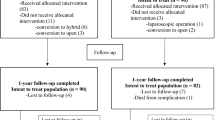Abstract
Background
Incisional hernia underwent a change from conventional techniques to mesh implantation. The relevance of different factors, like operative technique, mesh material, and patient-related parameters concerning the outcome following mesh repair, are still under debate.
Methods
In a comparative retrospective study of 421 incisional hernia operations on 348 patients, we investigated 241 Mayo procedures and 180 mesh repairs over a 25-year period. In addition to the quality of life following mesh implantation, the prognostic relevance of demographic, preoperative and intraoperative parameters, surgical technique, mesh material, and the surgeon’s experience were analysed, both in a univariate and multivariate manner.
Results
With a mean follow-up of 9.7±8.8 years, the total recurrence rate following Mayo overlap was 37%, in contrast to 15% after mesh implantation (P=0.001). Mesh size was the only significant prognostic factor concerning quality of life following mesh implantation, and 86% of the patients with mesh repair were satisfied. The complication rate was determined significantly by patients’ risk factors, size of hernia, operative technique, and the surgeon’s experience, whereas the rate of recurrences was significantly influenced by the parameters obesity (BMI>25), size of hernia, and surgical experience. The recurrence rate decreased significantly with surgeon’s experience—a minimum of 16 mesh repairs led to a recurrence rate of less than 10%.
Conclusions
Only the mesh repair revealed acceptable recurrence rates with high patient comfort. From a surgical point of view, the most important prognostic factor following mesh repair is the surgeon’s experience.



Similar content being viewed by others
References
Korenkov M, Sauerland S, Paul A, Neugebauer EAM (2002) Die deutsche Narbenhernienchirurgie im Umbruch. Ein Vergleich zweier Kliniksumfragen 1995 und 2001. 119. Kongress der Deutschen Gesellschaft für Chirurgie vom 07.-10.05.2002 in Berlin, ID 476
Langer C, Flosman M, Kley C, Liersch T, Becker H (2001) Rezidive und Komplikationen nach Narbenhernien-Netzplastik—Inzidenz, Ursache, Therapie. Viszeralchirurgie 36:161–168
Schumpelick V, Conze J, Klinge U (1996) Die präperitoneale Netzplastik in der Reparation der Narbenhernie. Chirurg 67:1028–1035
Paul A, Korenkov M, Peters S, Köhler L, Fischer S, Troidl H (1998) Unacceptable results of the Mayo procedure for repair of abdominal incisional hernias. Eur J Surg 164:361–367
Langer S, Christiansen J (1985) Long-term results after incisional hernia repair. Acta Chir Scand 151:217–219
Langer C, Neufang T, Kley C, Schönig KH, Becker H (2001) Standardisierte Polypropylennetzplastik der Narbenhernie in Sublay-Technik. Chirurg 72:953–957
Schumpelick V, Klosterhalfen B, Müller M, Klinge U (1999) Minimierte Polypropylen-Netze zur präperitonealen Netzplastik (PNP) der Narbenhernie. Chirurg 70:422–430
Courtney CA, Lee AC, Wilson C, O’Dwyer PJ (2003) Ventral hernia repair: A study of current practice. Hernia 7:44–46
Anthony T, Bergen PC, Kim LT, Henderson M, Fahey T, Rege RV, Turnage RH (2000) Factors affecting recurrence following incisional herniorraphy. World J Surg 24:95–101
Langer C, Kley C, Neufang T, Liersch T, Becker H (2001) Zur Problematik des Narbenhernienrezidivs nach Netzplastik der Bauchwand. Chirurg 72:927–933
Morris-Stiff GJ, Hughes LE (1998) The outcomes of nonabsorbable mesh placed within the abdominal cavity: literature review and clinical experience. J Am Coll Surg 186:352–367
Klinge U, Klosterhalfen B, Conze J, Limberg W, Obolenski B, Öttinger AP, Schumpelick V (1998) Modified mesh for hernia repair that is adapted to the physiology of the abdominal wall. Eur J Surg 164:951–960
Klinge U, Conze J, Klosterhalfen B, Limberg W, Obolenski B, Öttinger AP, Schumpelick V (1996) Veränderungen der Bauchwandmechanik nach Mesh-Implantation. Experimentelle Veränderung der Mesh-Stabilität. Langenbecks Arch Chir 381:323–332
McLanahan D, King LT, Weems C, Novotney M, Gibson K (1997) Retrorectus prosthetic mesh repair of midline abdominal hernia. Am J Surg 173:445–449
Vestweber KH, Lepique F, Haaf F, Horatz M, Rink A (1997) Netzplastiken bei Bauchwand-Rezidivhernien – Ergebnisse. Zentralbl Chir 122:885–888
Mayo WJ (1901) An operation for the radical cure of umbilical hernia. Ann Surg 34:276–280
Luijendijk R, Hop WCJ, van den Tol MP, de Lange DCD (2000) A comparison of suture repair with mesh repair for incisional hernia. N Engl J Med 343:392–8
Liakakos T, Karanikas I, Panagiotidis H, Dendrinos S (1994) Use of Marlex mesh in the repair of recurrent incisional hernia. Br J Surg 81:248–249
Schumpelick V, Klinge U, Welty G, Klosterhalfen B (1999) Meshes in der Bauchwand. Chirurg 70:876–887
Höer J, Lawong G, Klinge U, Schumpelick V (2002) Einflussfaktoren der Narbenhernienentstehung. Retrospektive Untersuchung an 2983 laparotomierten Patienten über einen Zeitraum von 10 Jahren. Chirurg 73:474–480
Klinge U, Si ZY, Zheng H, Schumpelick V, Bhardwaj RS, Klosterhalfen B (2000) Abnormal collagen I to III distribution in the skin of patients with incisional hernia. Eur Surg Res 32:43–48
Klinge U, Si ZY, Zheng H, Schumpelick V (2001) Collagen I/III and matrix metalloproteinases (MMP) 1 und 13 in the fascia of patients with incisional hernias. J Invest Surg 13:47–54
Gomez R, Hidalgo M, Marques E, Marin L, Loinaz C, Gonzalez I, Garcia I, Moreno E (2001) Incidence and predisposing factors for incisional hernia in patients with liver transplantation. Hernia 5:172–176
Author information
Authors and Affiliations
Corresponding author
Additional information
This paper was presented to the American Hernia Society Congress in Orlando, Fla., USA, on Feb. 26, 2004.
Rights and permissions
About this article
Cite this article
Langer, C., Schaper, A., Liersch, T. et al. Prognosis factors in incisional hernia surgery: 25 years of experience. Hernia 9, 16–21 (2005). https://doi.org/10.1007/s10029-004-0265-y
Received:
Accepted:
Published:
Issue Date:
DOI: https://doi.org/10.1007/s10029-004-0265-y




